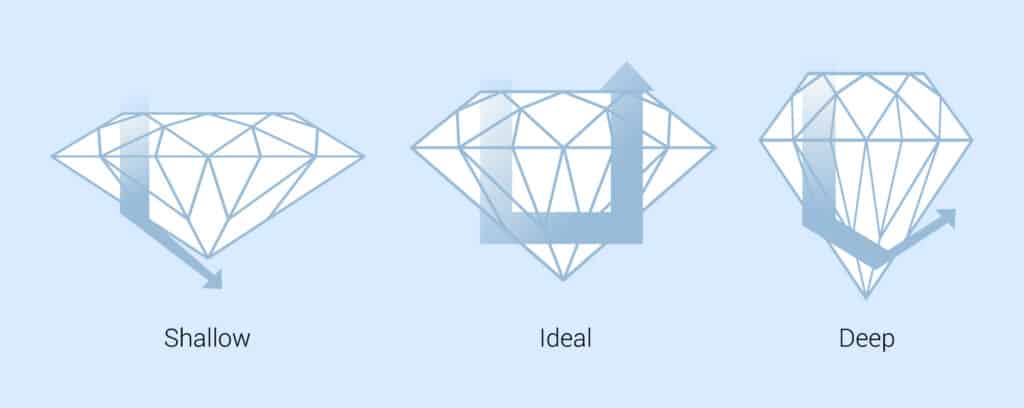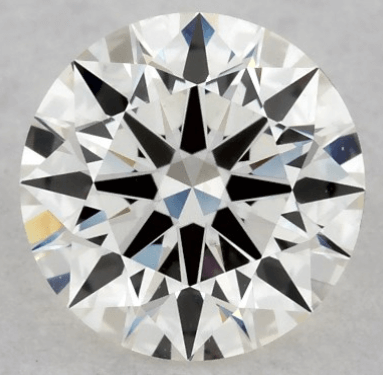We are reader-supported. Buying through any red colored link on our site may earn us commissions. Learn More.
Up to 30% off engagement rings and select jewelry at James Allen!
Many people envision a big diamond for their engagement ring. Whether it’s a 1 Carat or 3 Carat diamond, they have their eyes set on a large stone. But a diamond’s size isn’t the only thing that matters. In fact, it’s most important to choose a diamond that has an excellent cut. When a diamond’s facets and proportions are optimal, more light reflects off of the table—causing the diamond to shine. In other words, a smaller well-cut diamond will radiate far more than a large lifeless diamond.
Unfortunately, some jewelers are too focused on getting you to buy a diamond, even when it’s not a smart choice. That’s how spready diamonds originated—the stones look larger, even though they lack sparkle.
Spread diamonds refer to stones that have been cut in a way that maximizes their surface area, making them appear larger than their actual carat weight would suggest. While this might sound like an appealing feature, it’s important to understand that the cut may compromise other qualities of the diamond, such as brilliance and sparkle. If the diamond is too “spread,” the cut could be shallow, causing light to leak out instead of reflecting within the stone, diminishing its overall appearance.
When considering a spread diamond, the most crucial element to look at is the cut quality. Be cautious of diamonds that appear too shallow or flat, as they are likely to lack the sparkle and brilliance that make diamonds so appealing. Ensure that you are purchasing from reputable sellers and that the diamond comes with a certification from a recognized gemological laboratory, which will provide detailed information about the cut and other characteristics of the stone. The allure of getting a “bigger look for less” can be tempting, but remember that compromising too much on cut quality can result in a less brilliant and less valuable diamond.
Here we discuss what spread diamonds are and how best to evaluate a diamond’s cut for maximum beauty.
Why you should trust us
What are Spready Diamonds?
Spread diamonds, also known as “spready” diamonds, are shallow-cut diamonds. They look larger than other diamonds of their same carat weight. For example, with a spread diamond, the table is wider and the depth is shallower than the recommended cut parameters.
The larger “spread” of these diamonds may seem more appealing at first, but it’s important to look closely at the cut quality of the diamond. While the diamond might look larger, it lacks sparkle, beauty and value.
What happens when a Diamond Cut is too shallow?
When a diamond is cut too shallow, light hits the pavilion at a low angle. In these cases, light travels through the diamond and escapes out the sides, instead of reflecting back through the table to your eyes.

While spready diamonds appear large, their shallow cut has a huge impact on their light performance. As the American Gem Society explains here, when a diamond is shallow, the majority of the light exits out the bottom—reducing its brilliance and beauty. A shallow diamond means the facets aren’t angled to bounce light optimally and create sparkle.
”Cut quality is the factor that fuels a diamond’s fire, sparkle and brilliance. The allure and beauty of a particular diamond depends more on cut quality than anything else.” Gemological Institute of America (GIA)
What are the best cut proportions?
A diamond’s cut refers to how well proportioned it is. The cut determines the table size, width, depth, facets, scintillation and more. That’s why diamond cut is so important: it dictates the beauty and brilliance of the stone.
For any diamond shape, we recommend selecting an excellent or ideal cut diamond. These are the highest grading options for cut quality.
The grade’s just a starting point, though. You want to review each diamond individually. Look at the diamond with high-quality imagery and review the specs on the certificate.
For round diamonds, to maximize brilliance, keep the depth percentage below 62.5% and the table percentage below 59%. Here’s an example of a beautifully cut round diamond from James Allen. The table, facets and proportions are cut to maximize brilliance—giving it its signature sparkle.
For fancy shapes, like the pear or marquise, it’s usually more difficult to determine if the diamond is well-cut. Besides looking closely at the stone, enlist the help of an expert. We’ll review the diamond for you and let you know if the diamond is well-cut.
Pros and Cons of Spready Diamonds
When making a decision on a diamond, it’s important to weigh the advantages and disadvantages. Here are a few details that can help you make a decision on a spread diamond engagement ring.
Pros of Spready Diamonds
- Looks big for the price you pay
Cons of Spready Diamonds
- Lacks brilliance and sparkle (because the cut is too shallow)
- Less beauty
- Vulnerable to chipping
- Lower value
- Difficult to exchange or upgrade
Most spread diamonds are graded with a poor cut. That’s why we encourage you not to buy spready diamonds, and instead opt for a smaller stone with plenty of sparkle and character.
Should You Buy a Spready Diamond?

Spread diamonds might seem like a great buy because they look larger than other diamonds of the same carat weight. But they are cut too shallow to offer brilliance and sparkle. Light leaks out, rather than reflecting back to your eye. That’s why we strongly recommend staying away from spread diamonds.
Even if you purchase a lower carat weight stone, like a 0.71 carat diamond ring like this from Blue Nile, you’ll have far more beauty than buying a large, dull diamond. With a well-proportioned stone, you’ll have a ring that sparkles for years to come.
Frequently Asked Questions About Diamonds
There’s a lot to know about diamonds, and we’re here to help.
Here are the answers to commonly asked questions about diamonds. For one-on-one assistance, please contact our experts.
Which Diamond Cut Faces Up Largest?
The size of a diamond is determined by a few factors: its carat weight, shape and how the stone is cut. In general, the marquise diamond has the largest surface area of any diamond shape. Pear shaped diamonds and oval cut diamonds also look larger because of their elongated design.
It’s important to remember that a heavier carat weight doesn’t mean a larger sized diamond.
What Diamond Cut Looks Smaller?
Cushion cut and Asscher cut diamonds look the smallest because they’re deep cut stones with small surface areas. Compared to other shapes, a lot of their carat weight falls below the surface where it goes unseen.
Which Cut of Diamond Has the Most Sparkle?
Round brilliant cuts offer the most sparkle of any diamond shape. They’re cut with 58 facets that all reflect light off of the diamond’s table to your eyes. For over 100 years, diamond cutters have perfected the round diamond cutting process to maximize brilliance.
The oval, marquise and pear-shaped diamonds are runners-up to the round cut in terms of sparkle. These shapes are designed to allow the majority of light to be reflected off of their tables.
Which Cut of Diamond is the Most Expensive?
The most expensive diamond shape is the round cut diamond. Firstly, when round diamonds are cut, a significant amount of the rough stone is removed. The lower yield means a higher price because more rough stone is needed. Secondly, the round cut’s popularity boosts its price. Approximately 75% of all diamonds sold are round cut diamonds. Thirdly, the unmatched sparkle and beauty of a round cut warrant its higher price.
What is the Most Popular Diamond Cut?
Round cut diamonds are the most popular diamond shape. Approximately 60% of all engagement rings feature a round cut diamond and approximately 75% of all diamonds sold are round cuts.
Looking for the most beautiful diamond ring for your budget? Contact us for guidance.

- No questions asked returns within 30 days of shipment. James Allen will send you a paid shipping label to return the ring.
- Lifetime Warranty
- Free International Shipping
- Free prong tightening, repolishing, rhodium plating and cleaning every 6 months
- Provide insurance appraisals
- One free resizing within 60 days of purchase
- Free ring inscriptions
- Best-in-class high quality imagery of all diamonds in stock
- 24/7 Customer Service
- Best-in-class packaging


- No questions asked returns within 30 days of shipment. Blue Nile will send you a paid shipping label to return the ring.
- Lifetime Warranty
- Free Shipping
- Free prong tightening, repolishing, rhodium plating and cleaning every 6 months
- Provide insurance appraisal
- One free resizing within the first year of purchase
- High quality images of about half of their diamonds
- 24/7 Customer Service
- 100% credit towards future upgrades (must be at least double in value)
- Best in class fulfillment

Still afraid of getting ripped off?
Before you buy a diamond, get personal buying advice from industry veterans. We'll help you get the best diamond for the money.
Ask your diamond purchase question here
DISCLAIMER: We don't use your email for marketing. Period.
You Might Like
Diamond Prices: A Complete Guide
A diamonds’ price is determined primarily by the 4 Cs of the diamond. On the wholesale level, diamond prices are first based on a diamond shape and
The Best Places to Buy Engagement Rings
Buying an engagement ring is often one of the first major purchases in a person's life. The process can be fraught with tension as there are so m
1 Carat Diamond Price & Buying Guide
A wide range of 1 carat diamonds exist both in online markets and local diamond jewelry stores. Not only are there significant differences in beauty



